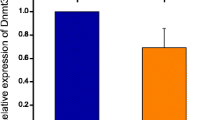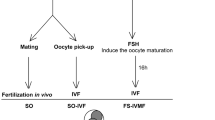Abstract
Purpose
This study aimed to determine the effects of drilling and thinning treatment of laser-assisted hatching on the expression and methylation of imprinted gene IGF2/H19 in embryos and offspring.
Methods
The prehatching blastocysts with treatment of drilling or thinning, or control prehatching blastocysts, were transplanted in surrogate uteri. The DNA methylation of IGF2/H19 imprinting control region (ICR) and the expression of IGF2 and H19 were respectively evaluated using bisulfite conversion-mediated sequencing and real-time PCR.
Results
The drilling group showed a significant increase in the development rate of hatched blastocysts in comparison with the control and thinning group. DNA methylation level of IGF2/H19 ICR of hatched blastocysts in the thinning group was 27.33% in comparison with the 38.67% and 36% observed in the control and drilling group. The thinning treatment increased the DNA methylation level of IGF2/H19 ICR in the placenta in comparison with the control and drilling group. The drilling and thinning treatment decreased the expression level of H19 mRNA in prehatching and hatched blastocysts as well as placenta, while a significant increase in the expression level of H19 mRNA of offspring was observed in the thinning group. The thinning treatment increased the expression level of IGF2 mRNA of prehatching blastocysts and offspring and a significant decrease in placenta, while the drilling treatment resulted in a significant increase in the expression level of IGF2 mRNA of hatched blastocysts and placenta.
Conclusion
These observations suggested that drilling used for hatching of in vitro cultured mouse blastocysts may improve the production of offspring.






Similar content being viewed by others
References
DeAngelis AM, Martini AE, Owen CM. Assisted reproductive technology and epigenetics. Semin Reprod Med. 2018;36(3-04):221–32. https://doi.org/10.1055/s-0038-1675780.
Litzky JF, Marsit CJ. Epigenetically regulated imprinted gene expression associated with IVF and infertility: possible influence of prenatal stress and depression. J Assist Reprod Genet. 2019;36(7):1299–313. https://doi.org/10.1007/s10815-019-01483-0.
Elhamamsy AR. Role of DNA methylation in imprinting disorders: an updated review. J Assist Reprod Genet. 2017;34(5):549–62. https://doi.org/10.1007/s10815-017-0895-5.
Osman E, Franasiak J, Scott R. Oocyte and embryo manipulation and epigenetics. Semin Reprod Med. 2018;36(3-04):e1–9. https://doi.org/10.1055/s-0039-1688801.
Li T, Vu TH, Ulaner GA, Littman E, Ling JQ, Chen HL, et al. IVF results in de novo DNA methylation and histone methylation at an Igf2-H19 imprinting epigenetic switch. Mol Hum Reprod. 2005;11(9):631–40. https://doi.org/10.1093/molehr/gah230.
Le F, Wang LY, Wang N, Li L, Li le J, Zheng YM, et al. In vitro fertilization alters growth and expression of Igf2/H19 and their epigenetic mechanisms in the liver and skeletal muscle of newborn and elder mice. Biol Reprod. 2013;88(3):75. https://doi.org/10.1095/biolreprod.112.106070.
Loke YJ, Galati JC, Saffery R, Craig JM. Association of in vitro fertilization with global and IGF2/H19 methylation variation in newborn twins. J Dev Orig Health Dis. 2015;6(2):115–24. https://doi.org/10.1017/S2040174415000161.
Cocchi G, Marsico C, Cosentino A, Spadoni C, Rocca A, De Crescenzo A, et al. Silver-Russell syndrome due to paternal H19/IGF2 hypomethylation in a twin girl born after in vitro fertilization. Am J Med Genet A. 2013;161A(10):2652–5. https://doi.org/10.1002/ajmg.a.36145.
Lim D, Bowdin SC, Tee L, Kirby GA, Blair E, Fryer A, et al. Clinical and molecular genetic features of Beckwith-Wiedemann syndrome associated with assisted reproductive technologies. Hum Reprod. 2009;24(3):741–7. https://doi.org/10.1093/humrep/den406.
Soejima H, Higashimoto K. Epigenetic and genetic alterations of the imprinting disorder Beckwith-Wiedemann syndrome and related disorders. J Hum Genet. 2013;58(7):402–9. https://doi.org/10.1038/jhg.2013.51.
Chopra M, Amor DJ, Sutton L, Algar E, Mowat D. Russell-Silver syndrome due to paternal H19/IGF2 hypomethylation in a patient conceived using intracytoplasmic sperm injection. Reprod BioMed Online. 2010;20(6):843–7. https://doi.org/10.1016/j.rbmo.2010.02.025.
Miyata H, Matsubayashi H, Fukutomi N, Matsuba J, Koizumi A, Tomiyama T. Relevance of the site of assisted hatching in thawed human blastocysts: a preliminary report. Fertil Steril. 2010;94(6):2444–7. https://doi.org/10.1016/j.fertnstert.2010.01.056.
Kim HJ, Lee KH, Park SB, Choi YB, Yang JB. The effect of artificial shrinkage and assisted hatching on the development of mouse blastocysts and cell number after vitrification. Clin Exp Reprod Med. 2015;42(3):94–100. https://doi.org/10.5653/cerm.2015.42.3.94.
Hernandez-Nieto CA, Soto-Cossio LE, Basurto-Diaz D. Assisted hatching for improving embryo implantation. A bibliographical review. Ginecol Obstet Mex. 2015;83(4):232–9.
Carney SK, Das S, Blake D, Farquhar C, Seif MM, Nelson L. Assisted hatching on assisted conception (in vitro fertilisation (IVF) and intracytoplasmic sperm injection (ICSI). Cochrane Database Syst Rev 2012;12:CD001894. https://doi.org/10.1002/14651858.CD001894.pub5.
Martins WP, Rocha IA, Ferriani RA, Nastri CO. Assisted hatching of human embryos: a systematic review and meta-analysis of randomized controlled trials. Hum Reprod Update. 2011;17(4):438–53. https://doi.org/10.1093/humupd/dmr012.
Jwa J, Jwa SC, Kuwahara A, Yoshida A, Saito H. Risk of major congenital anomalies after assisted hatching: analysis of three-year data from the national assisted reproduction registry in Japan. Fertil Steril. 2015;104(1):71–8. https://doi.org/10.1016/j.fertnstert.2015.03.029.
Kissin DM, Kawwass JF, Monsour M, Boulet SL, Session DR, Jamieson DJ, et al. Assisted hatching: trends and pregnancy outcomes, United States, 2000-2010. Fertil Steril. 2014;102(3):795–801. https://doi.org/10.1016/j.fertnstert.2014.06.013.
Malter HE, Cohen J. Blastocyst formation and hatching in vitro following zona drilling of mouse and human embryos. Gamete Res. 1989;24(1):67–80. https://doi.org/10.1002/mrd.1120240110.
Cohen J, Elsner C, Kort H, Malter H, Massey J, Mayer MP, et al. Impairment of the hatching process following IVF in the human and improvement of implantation by assisting hatching using micromanipulation. Hum Reprod. 1990;5(1):7–13. https://doi.org/10.1093/oxfordjournals.humrep.a137044.
Khalifa EA, Tucker MJ, Hunt P. Cruciate thinning of the zona pellucida for more successful enhancement of blastocyst hatching in the mouse. Hum Reprod. 1992;7(4):532–6. https://doi.org/10.1093/oxfordjournals.humrep.a137685.
Nakayama T, Fujiwara H, Yamada S, Tastumi K, Honda T, Fujii S. Clinical application of a new assisted hatching method using a piezo-micromanipulator for morphologically low-quality embryos in poor-prognosis infertile patients. Fertil Steril. 1999;71(6):1014–8. https://doi.org/10.1016/s0015-0282(99)00131-4.
Ilina IV, Khramova YV, Filatov MA, Semenova ML, Sitnikov DS. Femtosecond laser assisted hatching: Dependence of zona pellucida drilling efficiency and embryo development on laser wavelength and pulse energy. High Temp. 2016;54(1):46–51. https://doi.org/10.1134/S0018151X15060115.
Bock C, Reither S, Mikeska T, Paulsen M, Walter J, Lengauer T. BiQ Analyzer: visualization and quality control for DNA methylation data from bisulfite sequencing. Bioinformatics. 2005;21(21):4067–8. https://doi.org/10.1093/bioinformatics/bti652.
Wright G, Wiker S, Elsner C, Kort H, Massey J, Mitchell D, et al. Observations on the morphology of pronuclei and nucleoli in human zygotes and implications for cryopreservation. Hum Reprod. 1990;5(1):109–15. https://doi.org/10.1093/oxfordjournals.humrep.a137029.
DeMeestere I, Barlow P, Leroy F. Hardening of zona pellucida of mouse oocytes and embryos in vivo and in vitro. Int J Fertil Womens Med. 1997;42(3):219–22.
Blake DA, Forsberg AS, Johansson BR, Wikland M. Laser zona pellucida thinning--an alternative approach to assisted hatching. Hum Reprod. 2001;16(9):1959–64. https://doi.org/10.1093/humrep/16.9.1959.
Liu C, Su K, Shang W, Ji H, Yuan C, Cao M, et al. Higher implantation and live birth rates with laser zona pellucida breaching than thinning in single frozen-thawed blastocyst transfer. Lasers Med Sci. 2020;35(6):1349–55. https://doi.org/10.1007/s10103-019-02946-7.
Varrault A, Gueydan C, Delalbre A, Bellmann A, Houssami S, Aknin C, et al. Zac1 regulates an imprinted gene network critically involved in the control of embryonic growth. Dev Cell. 2006;11(5):711–22. https://doi.org/10.1016/j.devcel.2006.09.003.
Ono R, Nakamura K, Inoue K, Naruse M, Usami T, Wakisaka-Saito N, et al. Deletion of Peg10, an imprinted gene acquired from a retrotransposon, causes early embryonic lethality. Nat Genet. 2006;38(1):101–6. https://doi.org/10.1038/ng1699.
Li Q, Li Y, Yin Q, Huang S, Wang K, Zhuo L, et al. Temporal regulation of prenatal embryonic development by paternal imprinted loci. Sci China Life Sci. 2020;63(1):1–17. https://doi.org/10.1007/s11427-019-9817-6.
Honguntikar SD, Salian SR, D'Souza F, Uppangala S, Kalthur G, Adiga SK. Epigenetic changes in preimplantation embryos subjected to laser manipulation. Lasers Med Sci. 2017;32(9):2081–7. https://doi.org/10.1007/s10103-017-2334-3.
Koustas G, Sjoblom C. Minute changes to the culture environment of mouse pre-implantation embryos affect the health of the conceptus. Asian Pac J Reprod. 2016;5(4):287–94. https://doi.org/10.1016/j.apjr.2016.06.015.
Lanzendorf SE, Ratts VS, Moley KH, Goldstein JS, Dahan MH, Odem RR. A randomized, prospective study comparing laser-assisted hatching and assisted hatching using acidified medium. Fertil Steril. 2007;87(6):1450–7. https://doi.org/10.1016/j.fertnstert.2006.11.030.
Cohen J, Feldberg D. Effects of the size and number of zona pellucida openings on hatching and trophoblast outgrowth in the mouse embryo. Mol Reprod Dev. 1991;30(1):70–8. https://doi.org/10.1002/mrd.1080300110.
Yan Z, Liang H, Deng L, Long H, Chen H, Chai W, et al. Eight-shaped hatching increases the risk of inner cell mass splitting in extended mouse embryo culture. PLoS One. 2015;10(12):e0145172. https://doi.org/10.1371/journal.pone.0145172.
Skiadas CC, Missmer SA, Benson CB, Gee RE, Racowsky C. Risk factors associated with pregnancies containing a monochorionic pair following assisted reproductive technologies. Hum Reprod. 2008;23(6):1366–71. https://doi.org/10.1093/humrep/den045.
Vitthala S, Gelbaya TA, Brison DR, Fitzgerald CT, Nardo LG. The risk of monozygotic twins after assisted reproductive technology: a systematic review and meta-analysis. Hum Reprod Update. 2009;15(1):45–55. https://doi.org/10.1093/humupd/dmn045.
Jongbloet PH. Monozygotic twinning, structural defects, and syndromes “of obscure etiology”. J Pediatr. 1980;97(5):868–9. https://doi.org/10.1016/s0022-3476(80)80293-9.
Harkness UF, Crombleholme TM. Twin-twin transfusion syndrome: where do we go from here? Semin Perinatol. 2005;29(5):296–304. https://doi.org/10.1053/j.semperi.2005.10.001.
Padula F, Capriglione S, Iaconianni P, Gatti S, Lippa A, Minutolo SE, et al. Laser-assisted hatching of human embryos: may two alternative approaches (thinning versus drilling) impact on implant rate? Lasers Med Sci. 2017;32(7):1663–6. https://doi.org/10.1007/s10103-017-2242-6.
Tucker MJ, Luecke NM, Wiker SR, Wright G. Chemical removal of the outside of the zona pellucida of day 3 human embryos has no impact on implantation rate. J Assist Reprod Genet. 1993;10(3):187–91. https://doi.org/10.1007/bf01239219.
Mantoudis E, Podsiadly BT, Gorgy A, Venkat G, Craft IL. A comparison between quarter, partial and total laser assisted hatching in selected infertility patients. Hum Reprod. 2001;16(10):2182–6. https://doi.org/10.1093/humrep/16.10.2182.
Lu X, Liu Y, Cao X, Liu SY, Dong X. Laser-assisted hatching and clinical outcomes in frozen-thawed cleavage-embryo transfers of patients with previous repeated failure. Lasers Med Sci. 2019;34(6):1137–45. https://doi.org/10.1007/s10103-018-02702-3.
Watanabe H, Suzuki R, Kobayashi M, Hasegawa H, Tsukamoto K, Saitou S, et al. To what degree should the zona pellucida be cut open in assisted hatching for best clinical results? Fertil Steril. 2015;104(3):e185. https://doi.org/10.1016/j.fertnstert.2015.07.574.
Lee JW, Cha JH, Shin SH, Kim YJ, Lee SK, Park CK, et al. Effects of laser-assisted thinning versus opening on clinical outcomes according to maternal age in patients with repeated implantation failure. Lasers Med Sci. 2019;34(9):1889–95. https://doi.org/10.1007/s10103-019-02787-4.
Wang EH, Wang AC, Wang BS, Li B. Outcomes of vitrified-warmed cleavage-stage embryo hatching after in vitro laser-assisted zona pellucida thinning in patients. Biomed Rep. 2016;5(3):376–82. https://doi.org/10.3892/br.2016.716.
Germond M, Nocera D, Senn A, Rink K, Delacrétaz G, Fakan S. Microdissection of mouse and human zona pellucida using a 1.48-microns diode laser beam: efficacy and safety of the procedure. Fertil Steril. 1995;64(3):604–11. https://doi.org/10.1016/s0015-0282(16)57800-5.
Petrussa L, Van de Velde H, De Rycke M. Dynamic regulation of DNA methyltransferases in human oocytes and preimplantation embryos after assisted reproductive technologies. Mol Hum Reprod. 2014;20(9):861–74. https://doi.org/10.1093/molehr/gau049.
Edwards LJ, Kind KL, Armstrong DT, Thompson JG. Effects of recombinant human follicle-stimulating hormone on embryo development in mice. Am J Physiol Endocrinol Metab. 2005;288(5):E845–51. https://doi.org/10.1152/ajpendo.00398.2004.
Funding
The present study was supported by Guangxi Science Foundation (No. 2017GXNSFBA198189), the China National Natural Science Fund (No. 81960274, 81860733 and 81860285), Guangxi Bagui Scholar Program and the Key Project of Guangxi Natural Science Foundation (No. 2018GXNSFDA050003).
Author information
Authors and Affiliations
Contributions
PH, XL, and SZ directed the study; PH, KD, and ML performed the experiments; JY and JL performed the data collection and statistical analysis; JL edited the language; all the authors approved the manuscript for submission.
Corresponding authors
Ethics declarations
All mice were raised in the Experimental Animal Centre of Guilin under a good feeding condition. All procedures described within were reviewed and approved by the Experimental Animal Care and Use Committee of Guilin and were performed in accordance with the Guiding Principles for the Care and Use of Laboratory Animals.
Conflict of interest
The authors declare that they have no conflict of interest.
Additional information
Publisher’s note
Springer Nature remains neutral with regard to jurisdictional claims in published maps and institutional affiliations.
Rights and permissions
About this article
Cite this article
Huo, P., Deng, K., Wang, L. et al. The effect of laser-assisted hatching on the methylation and expression pattern of imprinted gene IGF2/H19 in mouse blastocysts and offspring. J Assist Reprod Genet 37, 3057–3067 (2020). https://doi.org/10.1007/s10815-020-01975-4
Received:
Accepted:
Published:
Issue Date:
DOI: https://doi.org/10.1007/s10815-020-01975-4




